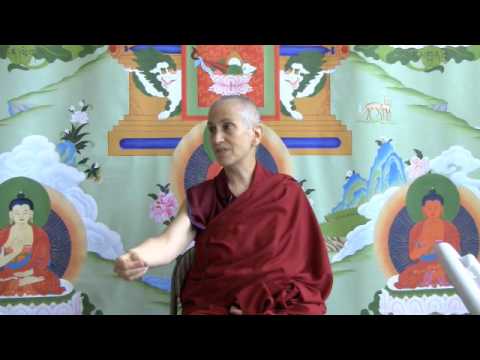Working on our attachments
Part of a series of Bodhisattva's Breakfast Corner talks given during the Green Tara Winter Retreat from December 2009 to March 2010.
- The importance of investigating the objects of our attachment and anger
- The role of inappropriate attention
Green Tara Retreat 023: Working on our attachments (download)
We talked about the woman who went around to bakeries, getting different brownies to see if they actually had the delicious taste in them that they were supposed to have. She concluded that they didn’t. That doesn’t mean that every time we’re attached to something, we should go around and sample it all to see if it’s actually as good as we thought it was going to be.
That was nice as a first experiment. It’s little bit fattening. But if every time we had attachment arising we said, “Well, let me explore it. I’ll just investigate it to see if it’s really as good as I think it is.” Then what happens is our mind gets overwhelmed by the attachment and we can’t pull back. That is not a wise thing to do. What we have to do instead is learn from previous mistakes that we’ve made regarding that object (or another object) and be able to look back and say, “Before, I got involved with this kind of behavior, this kind of thing, and look where it led me. It wasn’t worth it then. What I thought was the goodness in the object then wasn’t the goodness. So I don’t need to try it out again to test it.”
Similarly speaking, there may be a new situation that we haven’t done yet. You’re thinking, “This is really good. I want to go paragliding. I’ve never done that before. So I think I’ll do that to see if it’s really as good as I think.” Then what winds up happening is that you never stop trying new experiences because you think, “Maybe this one will be as good as I think it will.”
You also have to learn from other people’s experiences, either by listening to their experiences or stories, or by watching them to see what decisions people make thinking they’re going to be happy. Then watching and seeing if it turns out the way they thought it was going to turn out. We don’t have to constantly reinvent the wheel by trying out each and every attachment—because we’ll never get out of samsara that way.
We have to learn from our own experiences and learn from watching others. It’s the same with anger. We don’t have to get into our anger wholeheartedly and act on it each and every time to see if the thing that we’re upset about is really as bad as we thought it was going to be. We need to learn from past experiences when we’ve gotten angry. We also need to look at others’ experiences. We need to be smart about this exploration. Otherwise, every time the thought of brownies comes to mind, we’ll have to go around and taste them, and we’re going to have a weight problem!
Audience: What I’m curious about is if you have six people sitting in a room, you have a neutral feeling for five of them, and the sixth one you go, “Well, hello!” What is it that discerns, that actually makes that attachment manifest, when you have similar people (and things), and one sticks out as the object of attachment?
Venerable Thubten Chodron (VTC): So what happens when you have a bunch of people who are the same and one sticks out as the object of attachment or the object of hatred even?
Now, if you were a Svatantrika, you would say, “Well, it exists there in the person, some little bit. You’re exaggerating something, but something exists there in the person.” If you’re a Prasangika, you have to say, “No, it’s really being imputed from your mind.” So then what’s that mechanism? Well, there’s this thing called inappropriate attention. It’s the one that takes something and then just exaggerates or projects it. Sometimes I think that can happen because of certain karma. Scientists may say that it’s due to pheromones. But I think it’s more probably due to karma. There’s some kind of karmic relationship with the person that you then see them and your mind just starts projecting there. Or, it might be a combination of both things if you’re talking about sexual attraction. There are other kinds of attraction that are probably not due to pheromones. Who knows, likely some kind of karma.
The same thing can happen with anger. Some people’s look may remind you of somebody else that you knew, with whom you didn’t have a good relationship. Or they’re the same size as somebody else, or the same build, or they have the same name, and instantly your mind just projects the stuff from the past onto this person. They’re buried beneath your garbage before you even know their name. That can often come through karma or just through the mechanism in this life by which we project things onto other people. We associate things.
Audience: Is inappropriate attention a separate mental factor or an attention colored by the afflictions?
VTC: Well, it boils down to the same thing. It’s a mental factor that’s in a mindstream that also has afflictions in that mindstream. You have the primary mind, let’s say the mental consciousness, that has many different mental factors. One of them is going to be inappropriate attention. In that same mind you’re going to have other mental factors, and one might be attachment. That attachment is going to color your inappropriate attention and go back and forth between that. You might have inappropriate attention causing attachment, and then the attachment boosting up the inappropriate attention.
Venerable Thubten Chodron
Venerable Chodron emphasizes the practical application of Buddha’s teachings in our daily lives and is especially skilled at explaining them in ways easily understood and practiced by Westerners. She is well known for her warm, humorous, and lucid teachings. She was ordained as a Buddhist nun in 1977 by Kyabje Ling Rinpoche in Dharamsala, India, and in 1986 she received bhikshuni (full) ordination in Taiwan. Read her full bio.


